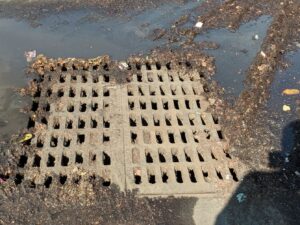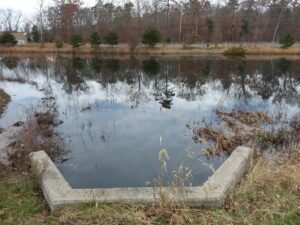Asset Management
Asset Management is the process of ensuring that there is sufficient investment in planned maintenance, needed repair, replacement, and upgrade of the physical components of the stormwater management system(s). These physical components of the system infrastructure are considered assets. Sufficient investment in the proper ongoing maintenance and repairs of stormwater infrastructure assets will preserve the service life of those assets and delay more costly repairs and even costlier replacements.

Asset Management is one of the most important aspects of effectively managing stormwater infrastructure and is becoming more and more crucial due to the greater frequency and intensity of storms as a result of climate change. Failure to perform the necessary upkeep and maintenance of stormwater infrastructure can lead to flooding which many communities across New Jersey experience during rain events. In addition to flooding, inadequate upkeep and maintenance can lead to other health and safety problems, such as creating mosquito breeding and vermin habitats, and areas with the potential for drowning. Excess organic material, debris, and other pollutants that accumulate in stormwater facilities due to a lack of maintenance can also be carried in the stormwater runoff, causing increases in nutrient levels in streams and lakes, Harmful Algal Blooms (HABs), eutrophication, and many other water quality impairments.

First and foremost, regardless of the entity responsible for a stormwater management system, whether it is a town, private development, or a stormwater utility formed under the Act, to achieve effective asset management, a full mapping and inventory of all stormwater management system infrastructure under the entity’s jurisdiction is needed, as well as an assessment of the current state of all those infrastructure assets. Then, the Asset Management Program and Plan can be developed to prioritize necessary investments for those assets. This information is necessary to ensure that maintenance, repair, and replacement of each component of that infrastructure can be scheduled in a proactive, rather than a reactive, manner.
The Asset Management Plan incorporates detailed asset inventories, required operation and maintenance (O&M) tasks for those assets, and a long-range financial planning strategy to ensure that annual revenue reserves and reinvestment strategies are sufficient enough to facilitate long-term viability of all assets in the system.
The five major steps in developing an Asset Management Program, as discussed in more detail below, are:
- Perform an inventory and condition assessment of the system’s assets

- Refer to the related requirements in MS4 & CSO permits
- Define Level of Service (LOS) goals
- See Establishing a Stormwater Utility regarding Level of Service (LOS) options
- Include available manufacturer specifications for all appropriate assets
- Include Maintenance Plan specifications
- When no specific maintenance specifications are available, refer to the Department’s Maintenance Guidance at NJDEP New Jersey Department of Environmental Protection (njstormwater.org)
- Prioritize and schedule asset maintenance, repair, and replacement based on criticality and Business Risk Exposure (BRE) evaluation
- Establish life cycle costs of each asset in the asset inventory
- Develop a long-term funding strategy to meet the defined LOS goals
The Department regulates stormwater runoff from municipal separate storm sewer systems (MS4s) owned or operated by towns and other MS4 permittees in the state via the MS4 General permits. While the MS4 permits do not specifically require official Asset Management Programs or Asset Management Plans, many of the permit requirements mirror the components of both an Asset Management Program and an Asset Management Plan. Completing an Asset Management Program and Plan could satisfy a number of MS4 permit requirements while also meeting the asset management requirements of operating a stormwater utility. Specifically, the permit requires that a Tier A municipality’s stormwater infrastructure be inventoried and that outfalls be mapped electronically. The permit also requires that manufacturer’s maintenance plans are kept by the municipality, and ongoing maintenance of both public and private stormwater facilities is tracked and performed. These requirements are staples of an Asset Management Program and Plan. (See https://njdepwptest.net/njpdes-stormwater/municipal-stormwater-regulation-program/ for specific permit requirements)
If the service area of an SWU is larger than just one municipality, the infrastructure inventory, outfall mapping, maintenance plan inventory, as well as any other asset management activities conducted by the towns, should be integrated into a more comprehensive asset management program and plan by the SWU.
Additionally, the Department requires Asset Management through the Combined Sewer Overflow (CSO) permits. While only a small percentage of municipalities in the state operate a combined sewer system, these cities and towns were required to develop a formal Asset Management Plan by July 1, 2016. The Department has developed an assessment checklist as part of the CSO program to assist in creating an Asset Management Plan. The CSO assessment checklist and other asset management guidance for CSOs can be found here https://www.nj.gov/dep/dwq/cso-guidance.htm.
Other asset management guidance is available from the Department at https://www.nj.gov/dep/assetmanagement/ and https://www.nj.gov/dep/floodresilience/toolkit.html.
The first step in managing stormwater assets is to complete a comprehensive asset inventory and associated map of all system components ( e.g., pipes, inlets, catch basins, stormwater management facilities, pumps, outfalls, storage tanks), and any other components that make up the stormwater management system. This list of components from the preliminary and comprehensive feasibility studies in Establishing a Stormwater Utility page is copied here for reference. Most aspects of this task may have already been completed prior to, or as part of, those feasibility studies.
-
-
- storm sewer manholes
- storm drain inlets*
- catch basins*
- retention basins*
- detention basins*
- vegetative filter strips*
- riparian buffers
- infiltration basins
- sand filters*
- constructed wetlands*
- wet pond*
- bioretention systems*
- low flow bypasses
- cisterns
- green roofs
- blue roofs
- pervious pavement
- manufactured treatment devices (MTDs)*
- stormwater conveyances (channels, pipes, ditches, etc.)
- any other less common stormwater related facilities, such as stormwater pump stations, flood control devices, etc.
-
Once mapped and inventoried, the next critical steps are to determine the condition and the remaining useful life of each identified and catalogued component.
While it may be more efficient in some cases to obtain all physical information regarding each component during one inspection rather than conducting repetitive inspections, completing the inventory, mapping, and cataloguing of component information may occur in multiple steps as follows.
- Initial – Inventory and mapping
- Develop a database listing at least the key stormwater infrastructure components, such as infiltration basins, detention basins, pump stations, outfalls, etc. and their general locations.
- Conduct field inspections to verify and GPS the locations and elevations of these components to add to the existing database and electronic outfall maps.
- All relevant photos taken during each field inspection should be added to the database.
- Interim – Enhance infrastructure information in database
- Update the database with pertinent information regarding each component, such as the type, material, size, manufacturer, the date it was installed, elevation, date of inspection(s) and observed condition, etc.
- Approximate dates of installation may be used for older infrastructure where records are not available.
- Final – Complete database
- Ensure that all remaining stormwater infrastructure, such as storm drain inlets, catch basins, conveyances, interconnections with other entities, etc. (as noted above) are included in the database, along with their relevant information.
- Include infrastructure information in the database regarding the remaining useful life, maintenance schedules, service agreements or contracts for maintenance, along with emergency contact information, and responsible parties.
- MS4 s hared service agreements will be necessary where an SWU is performing permit required tasks, such as maintenance, for an MS4 permittee.
The purpose of developing this Asset Management database is to ensure that all system assets have been inventoried and that their condition and remaining useful life have been determined and documented so that future management and capital project decisions can occur for their maintenance, repair and replacement .
Having an inventory of assets that includes both spatial location and condition will help inform future management and capital project decisions.
This endeavor serves as the essential bridge that can demonstrate how priorities were determined in the Operations & Maintenance Plans, Capital Improvement Plans and Financial Management Strategy which are discussed in detail at NJDEP-Asset Management Policy Program.
 Level of Service (LOS) refers to the intended goals of the stormwater program, with consideration of the role and function of infrastructure assets and how they are expected to perform. LOS considerations involve the components, services, and goals that are deemed appropriate by the stormwater program and the customers, with the minimum LOS ensuring that all regulatory requirements are met. A discussion about evaluating SWU LOS options is included under the Comprehensive Feasibility Study section on the Establishing a Stormwater Utility page.
Level of Service (LOS) refers to the intended goals of the stormwater program, with consideration of the role and function of infrastructure assets and how they are expected to perform. LOS considerations involve the components, services, and goals that are deemed appropriate by the stormwater program and the customers, with the minimum LOS ensuring that all regulatory requirements are met. A discussion about evaluating SWU LOS options is included under the Comprehensive Feasibility Study section on the Establishing a Stormwater Utility page.
LOS goals are essential to establishing how and when maintenance, repairs, and replacements are scheduled. Progress toward meeting these goals should be tracked to ensure that they are met in the time frames expected. The goals should be re-evaluated and updated on a set schedule to account for changes in areas such as growth, regulatory requirements, customer requests, and/or technology improvements.
LOS goals can be, but are not limited to, the following areas (with the exception of the first one, which is mandatory):
- Full compliance with the requirements of the MS4 permit, and the CSO permit, if applicable
- This mandatory goal is applicable to MS4 and CSO permittees, but if a stormwater utility is performing permit related duties for an MS4 permittee, those duties are required under the MS4 permit to be memorialized in an MS4 shared services agreements
- Responsibilities under any Shared Services Agreements
- Resolution of stormwater related flooding
- Customer Service/Accountability
- Stormwater Collection/Treatment Efficiency through proper operations and maintenance
- Social and Environmental Considerations
- Including those raised during stakeholder and public outreach
A function central to managing stormwater assets is justifying timely investments in repairing or replacing particular assets before others. To responsibly prioritize the repair or replacement of specific infrastructure components, informed management decisions must be made based on the criticality of an asset and the risk and significance of failure of the operation of that component, especially considering public health and safety. The failure of an asset may be dangerous and put the public’s health and safety at risk, as well as potentially compromising the system’s ability to function and meet other performance standards. In addition to safety concerns, this compromised function exposes the owner or operator, and potentially its customers, to adverse consequences from financial and regulatory standpoints. Greater adverse consequences from these risks are associated with assets deemed critical to public safety, the operation of the system, and those that are more likely to fail before reaching the end of their useful life due to damage or accelerated deterioration.
“Business risk exposure” (BRE) is a method of calculating (scoring) the nature and level of exposure that is likely to result from a potential failure of a specified asset. Determining the criticality of system assets is necessary to determine the priority order in which infrastructure  components will be addressed as part of the asset management program. Therefore, when conducting a prioritization assessment of system assets, the key questions that should be considered are:
components will be addressed as part of the asset management program. Therefore, when conducting a prioritization assessment of system assets, the key questions that should be considered are:
- Which assets are most critical to public health and safety?
- Which assets are most critical to the sustained function of the system?
- What is the likelihood of each of these assets failing?
- What are the consequences if an asset fails?
Together, the probability and consequence of failure of an asset indicates the Business Risk Exposure (BRE) or criticality of that asset.
 Life Cycle Costing is key to effective Asset Management. Essentially, it involves developing a schedule for maintenance, repair, and replacement, as well as capital improvements, that is informed by the criticality/prioritization assessment above. Knowing exactly what type and frequency of maintenance to perform on an asset, as well as the correct time to replace the asset optimizes operational and capital expenditures. Prioritizing maintenance, repair and replacement activities on those assets with a high BRE/criticality rating is a good starting point.
Life Cycle Costing is key to effective Asset Management. Essentially, it involves developing a schedule for maintenance, repair, and replacement, as well as capital improvements, that is informed by the criticality/prioritization assessment above. Knowing exactly what type and frequency of maintenance to perform on an asset, as well as the correct time to replace the asset optimizes operational and capital expenditures. Prioritizing maintenance, repair and replacement activities on those assets with a high BRE/criticality rating is a good starting point.
Many utility management software programs include automated maintenance schedules, work order management, and Capital Improvement Plan capabilities that significantly reduce the need for staff to monitor maintenance and/or forecast the rehabilitation or replacement of assets. These programs, however, are only as good as the accuracy and reliability of the data inputs, emphasizing the importance of the inventory, mapping, condition and criticality assessment discussed above.
A funding plan to support Asset Management will be developed by utilizing the knowledge about the system’s assets, including their condition, risk of failure and the consequences of a failure. The funding strategy will also be guided by the condition assessment, asset prioritization and resulting Life Cycle Costing. 
This funding strategy should include funding source(s) and estimated annual expenditures. The annual expenditures need to include the scheduled maintenance/repair/replacement of assets based on the analysis performed in Life Cycle Costing, and BRE evaluation to ensure a system’s performance meets or exceeds the LOS goals.
For SWUs, the primary funding source is the revenue generated from the fees discussed on the Fees, Credits and Exemptions page. Other possible funding sources are discussed in more detail below.
 An Asset Management Plan documents the Asset Management Program. The Asset Management Plan should be considered a set of documents and resources that guide and inform the day-to-day activities and decision-making associated with its Asset Management Program. Continuous change is inevitable and the Asset Management Program and Plan will require review, revisions, and updates on a regular basis. The Asset Management Plan should be maintained in an electronic format so that it can be easily revised and updated, and allow easy access and review by all staff that will be involved in related activities, such as operations, scheduling of maintenance, performing repairs and replacement of assets.
An Asset Management Plan documents the Asset Management Program. The Asset Management Plan should be considered a set of documents and resources that guide and inform the day-to-day activities and decision-making associated with its Asset Management Program. Continuous change is inevitable and the Asset Management Program and Plan will require review, revisions, and updates on a regular basis. The Asset Management Plan should be maintained in an electronic format so that it can be easily revised and updated, and allow easy access and review by all staff that will be involved in related activities, such as operations, scheduling of maintenance, performing repairs and replacement of assets.
As the Asset Management Plan will be revised periodically as the Asset Management Program is evaluated and revised, it is useful to identify goals for both short-term and long-term revision processes. Stormwater entities should not only identify what steps will be taken to develop an Asset Management Program and Plan, but also what steps will be needed to revise and improve the program and plan over time.
Many costs associate with the Asset Management Plan may be able to be financed through the New Jersey Water Bank (NJWB)  The NJWB provides low-cost financing for environmental infrastructure projects with the goal to enhance and protect ground and surface water resources and ensuring the safety of drinking water, while creating jobs critical to our State’s economy.
The NJWB provides low-cost financing for environmental infrastructure projects with the goal to enhance and protect ground and surface water resources and ensuring the safety of drinking water, while creating jobs critical to our State’s economy.
As of 2020, the financing program has provided more than $6.2 billion in loans to local and county government units and public water systems for wastewater treatment, combined sewer overflow abatement, stormwater, remediation, open space preservation, and drinking water projects, reducing each customer’s cost of borrowing by 25%.
These financing opportunities are discussed further under Additional SWU Funding Considerations on the Fees, Credits and Exemptions page as well. SWUs as well as municipalities may also apply for additional funding/financing from the Water Quality Restoration Grants for Nonpoint Source Pollution for various stormwater projects, including those related to combined sewer overflows. Further information regarding these financing opportunities is available at https://www.nj.gov/dep/dwq/mface_njeifp.htm and NJDEP-Division of Water Monitoring and Standards, respectively.